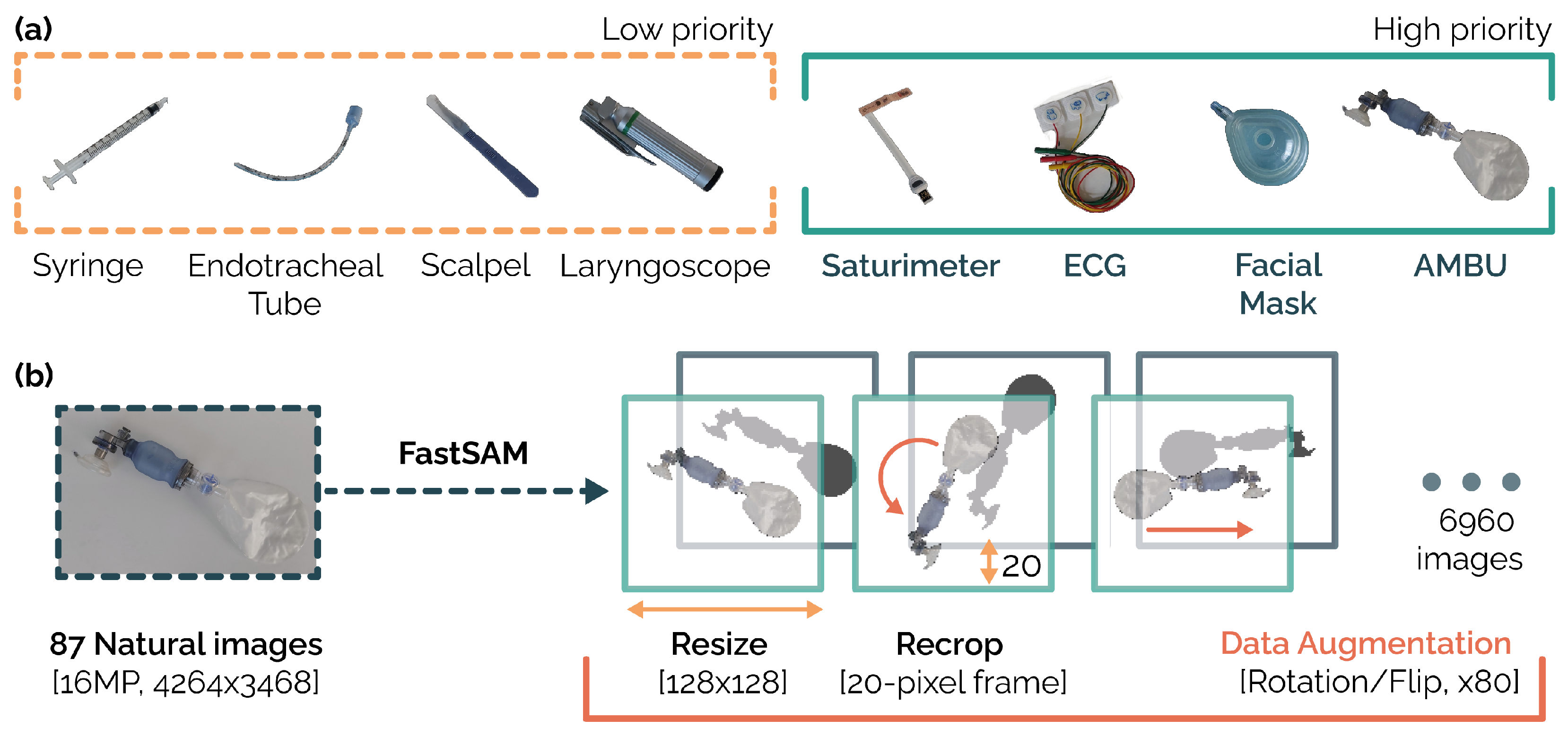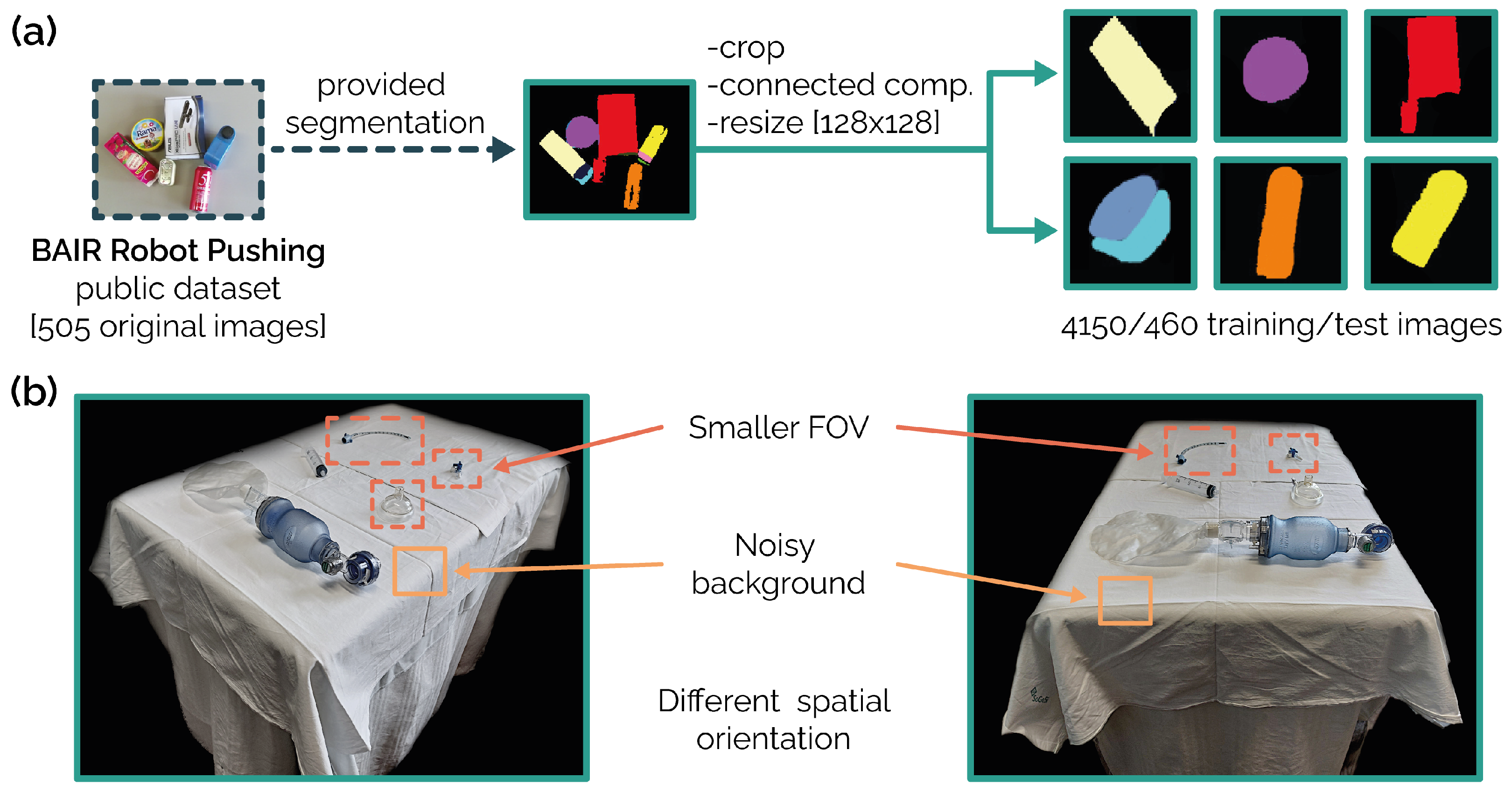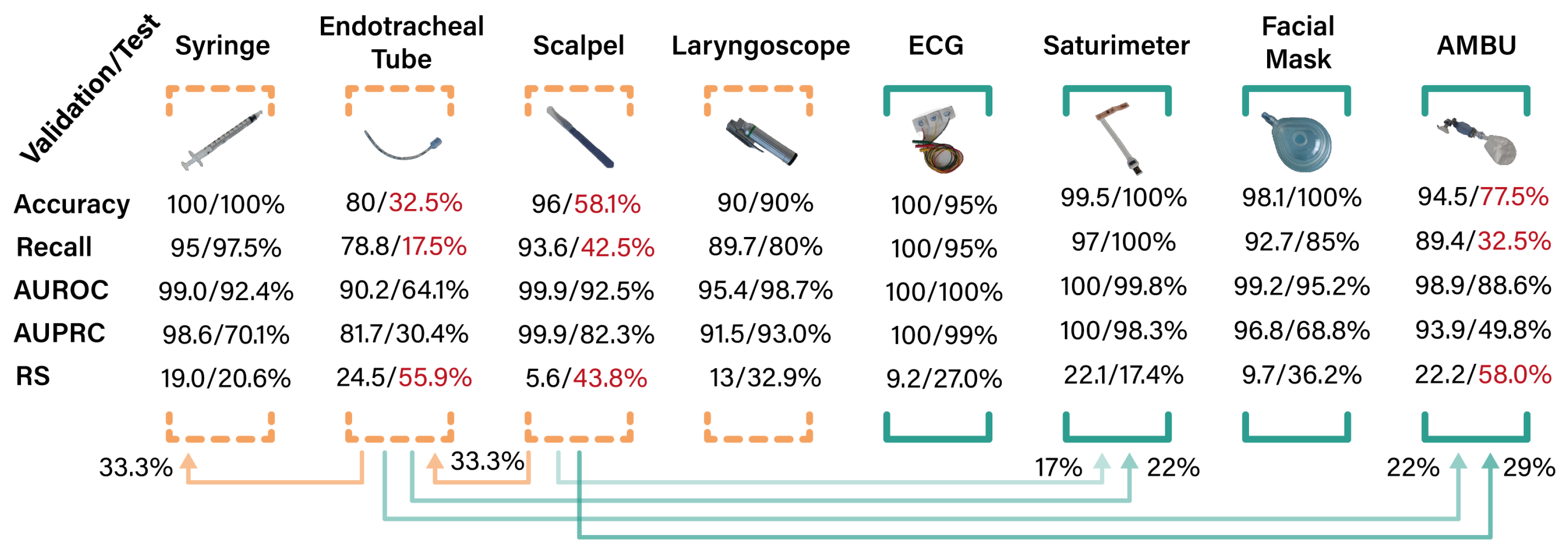Few-Shot Conditional Learning: Automatic and Reliable Device Classification for Medical Test Equipment
Abstract
1. Introduction
2. Data Acquisition and Preparation
2.1. Medical Equipment Dataset
2.2. Model Equipment Test Dataset
2.3. BAIR Robot Pushing Dataset
3. Materials and Methods
3.1. Few-Shot Problem Definition
3.2. Proposal
3.3. Define a Reliability Score
3.4. Experiments
3.4.1. ResNet
3.4.2. Masks Encoder
3.4.3. Few-Shot Experiments
3.4.4. Inference
4. Results
4.1. Masks Encoder Pre-Training
4.2. Meta-Validation Results
4.3. Details on Equipment and Reliability
4.4. Test Results by Preparatory Table
5. Discussion and Conclusions
Author Contributions
Funding
Data Availability Statement
Conflicts of Interest
Abbreviations
| FSL | Few-shot learning |
| STD | Standard deviation |
| IQR | Interquartile range |
| CV | Cross-validation |
| RS | Reliability score |
| TS | Trust score |
| ET | Endotracheal Tube |
| AUROC | Area Under the Receiver Operating Characteristic Curve |
| AUPRC | Area Under the Precision–Recall Curve |
References
- Cheng, G.; Xie, X.; Han, J.; Guo, L.; Xia, G.S. Remote Sensing Image Scene Classification Meets Deep Learning: Challenges, Methods, Benchmarks, and Opportunities. IEEE J. Sel. Top. Appl. Earth Obs. Remote Sens. 2020, 13, 3735–3756. [Google Scholar] [CrossRef]
- Hussain, E.; Hasan, M.; Rahman, M.A.; Lee, I.; Tamanna, T.; Parvez, M.Z. CoroDet: A deep learning based classification for COVID-19 detection using chest X-ray images. Chaos Solitons Fractals 2021, 142, 110495. [Google Scholar] [CrossRef]
- Khan, F.; Zafar, N.; Tahir, M.N.; Aqib, M.; Waheed, H.; Haroon, Z. A mobile-based system for maize plant leaf disease detection and classification using deep learning. Front. Plant Sci. 2023, 14, 1079366. [Google Scholar] [CrossRef]
- Serrano, C.; Lazo, M.; Serrano, A.; Toledo-Pastrana, T.; Barros-Tornay, R.; Acha, B. Clinically Inspired Skin Lesion Classification through the Detection of Dermoscopic Criteria for Basal Cell Carcinoma. J. Imaging 2022, 8, 197. [Google Scholar] [CrossRef]
- Hüllermeier, E.; Waegeman, W. Aleatoric and epistemic uncertainty in machine learning: An introduction to concepts and methods. Mach. Learn. 2021, 110, 457–506. [Google Scholar] [CrossRef]
- Kuleshov, V.; Liang, P.S. Calibrated structured prediction. Adv. Neural Inf. Process. Syst. 2015, 28, 3474–3482. [Google Scholar]
- Guo, C.; Pleiss, G.; Sun, Y.; Weinberger, K.Q. On calibration of modern neural networks. In Proceedings of the International Conference on Machine Learning, PMLR, Sydney, Australia, 6–11 August 2017; pp. 1321–1330. [Google Scholar]
- Goodfellow, I.J.; Shlens, J.; Szegedy, C. Explaining and harnessing adversarial examples. arXiv 2014, arXiv:1412.6572. [Google Scholar]
- Nguyen, A.; Yosinski, J.; Clune, J. Deep neural networks are easily fooled: High confidence predictions for unrecognizable images. In Proceedings of the IEEE Conference on Computer Vision and Pattern Recognition, Boston, MA, USA, 7–12 June 2015; pp. 427–436. [Google Scholar]
- Wang, Y.; Yao, Q.; Kwok, J.T.; Ni, L.M. Generalizing from a few examples: A survey on few-shot learning. ACM Comput. Surv. 2020, 53, 63. [Google Scholar] [CrossRef]
- Wang, Z.; Li, J.; Wang, W.; Dong, Z.; Zhang, Q.; Guo, Y. Review of few-shot learning application in CSI human sensing. Artif. Intell. Rev. 2024, 57, 195. [Google Scholar] [CrossRef]
- Sun, J.; Cao, W.; Fu, X.; Ochi, S.; Yamanaka, T. Few-shot learning for plant disease recognition: A review. Agron. J. 2024, 116, 1204–1216. [Google Scholar] [CrossRef]
- Galán-Cuenca, A.; Gallego, A.J.; Saval-Calvo, M.; Pertusa, A. Few-shot learning for COVID-19 chest X-ray classification with imbalanced data: An inter vs. intra domain study. Pattern Anal. Appl. 2024, 27, 69. [Google Scholar] [CrossRef]
- Sun, L.; Zhang, M.; Wang, B.; Tiwari, P. Few-shot class-incremental learning for medical time series classification. IEEE J. Biomed. Health Inform. 2023, 28, 1872–1882. [Google Scholar] [CrossRef]
- Mihretie, G.N.; Liyeh, T.M.; Ayele, A.D.; Kassa, B.G.; Belay, H.G.; Aytenew, T.M.; Sewuye, D.A.; Birhane, B.M.; Misk, A.D.; Alemu, B.K. Knowledge and skills of newborn resuscitation among health care professionals in East Africa. A systematic review and meta-analysis. PLoS ONE 2024, 19, e0290737. [Google Scholar] [CrossRef] [PubMed]
- Patel, A.B.; Bang, A.; Kurhe, K.; Bhargav, S.; Hibberd, P.L. What Helping Babies Breathe knowledge and skills are formidable for healthcare workers? Front. Pediatr. 2023, 10, 891266. [Google Scholar] [CrossRef]
- Tolsgaard, M.; Konge, L.; Bjerrum, F.; Thomsen, A.S.S.; Gustafsson, A. Implementation of evidence-based simulation training. Ugeskr. Laeger 2019, 181, V02190086. [Google Scholar]
- Vadla, M.S.; Moshiro, R.; Mdoe, P.; Eilevstjønn, J.; Kvaløy, J.T.; Hhoki, B.H.; Ersdal, H. Newborn resuscitation simulation training and changes in clinical performance and perinatal outcomes: A clinical observational study of 10,481 births. Adv. Simul. 2022, 7, 38. [Google Scholar] [CrossRef]
- Palmer, E.; Labant, A.L.; Edwards, T.F.; Boothby, J. A collaborative partnership for improving newborn safety: Using simulation for neonatal resuscitation training. J. Contin. Educ. Nurs. 2019, 50, 319–324. [Google Scholar] [CrossRef]
- Bardelli, S.; Del Corso, G.; Ciantelli, M.; Del Pistoia, M.; Lorenzoni, F.; Fossati, N.; Scaramuzzo, R.T.; Cuttano, A. Improving pediatric/neonatology residents’ newborn resuscitation skills with a digital serious game: DIANA. Front. Pediatr. 2022, 10, 842302. [Google Scholar] [CrossRef]
- Hinder, M.; Tracy, M. Newborn resuscitation devices: The known unknowns and the unknown unknowns. Semin. Fetal Neonatal Med. 2021, 26, 101233. [Google Scholar] [CrossRef]
- Ebert, F.; Finn, C.; Lee, A.X.; Levine, S. Self-Supervised Visual Planning with Temporal Skip Connections. CoRL 2017, 12, 16. [Google Scholar]
- American Academy of Pediatrics and American Heart Association. Textbook of Neonatal Resuscitation (NRP); American Academy of Pediatrics and American Heart Association: Itasca, IL, USA, 2016. [Google Scholar]
- Zhao, X.; Ding, W.; An, Y.; Du, Y.; Yu, T.; Li, M.; Tang, M.; Wang, J. Fast segment anything. arXiv 2023, arXiv:2306.12156. [Google Scholar]
- Kirillov, A.; Mintun, E.; Ravi, N.; Mao, H.; Rolland, C.; Gustafson, L.; Xiao, T.; Whitehead, S.; Berg, A.C.; Lo, W.Y.; et al. Segment anything. In Proceedings of the IEEE/CVF International Conference on Computer Vision, Paris, France, 2–3 October 2023; pp. 4015–4026. [Google Scholar]
- Snell, J.; Swersky, K.; Zemel, R. Prototypical networks for few-shot learning. In Advances in Neural Information Processing Systems; Curran Associates Inc.: Red Hook, NY, USA, 2017; Volume 30. [Google Scholar]
- Jiang, H.; Kim, B.; Guan, M.; Gupta, M. To trust or not to trust a classifier. In Advances in Neural Information Processing Systems; Curran Associates Inc.: Red Hook, NY, USA, 2018; Volume 31. [Google Scholar]
- Tenenbaum, J. Mapping a manifold of perceptual observations. In Advances in Neural Information Processing Systems; Curran Associates Inc.: Red Hook, NY, USA, 1997; Volume 10. [Google Scholar]
- McInnes, L.; Healy, J.; Melville, J. Umap: Uniform manifold approximation and projection for dimension reduction. arXiv 2018, arXiv:1802.03426. [Google Scholar]
- Mahmud, M.S.; Huang, J.Z.; Fu, X. Variational autoencoder-based dimensionality reduction for high-dimensional small-sample data classification. Int. J. Comput. Intell. Appl. 2020, 19, 2050002. [Google Scholar] [CrossRef]
- Del Corso, G. Uncertainty Analysis of Biological Systems: Towards a Digital Twin of the Human Heart. Ph.D. Thesis, Gran Sasso Science Institute, L’Aquila, Italy, 2022. [Google Scholar]
- Janssen, H. Monte-Carlo based uncertainty analysis: Sampling efficiency and sampling convergence. Reliab. Eng. Syst. Saf. 2013, 109, 123–132. [Google Scholar] [CrossRef]
- Alibrahim, H.; Ludwig, S.A. Hyperparameter optimization: Comparing genetic algorithm against grid search and bayesian optimization. In Proceedings of the 2021 IEEE Congress on Evolutionary Computation (CEC), Kraków, Poland, 28 June–1 July 2021; pp. 1551–1559. [Google Scholar]
- Wang, Z.; Bovik, A.; Sheikh, H.; Simoncelli, E. Image quality assessment: From error visibility to structural similarity. IEEE Trans. Image Process. 2004, 13, 600–612. [Google Scholar] [CrossRef]
- Zhou, Z.H. Ensemble Methods: Foundations and Algorithms; CRC Press: Boca Raton, FL, USA, 2012. [Google Scholar]
- Wertheimer, D.; Hariharan, B. Few-shot learning with localization in realistic settings. In Proceedings of the IEEE/CVF Conference on Computer Vision and Pattern Recognition, Long Beach, CA, USA, 15–20 June 2019; pp. 6558–6567. [Google Scholar]
- Xie, J.; Long, F.; Lv, J.; Wang, Q.; Li, P. Joint distribution matters: Deep brownian distance covariance for few-shot classification. In Proceedings of the IEEE/CVF Conference on Computer Vision and PATTERN Recognition, New Orleans, LA, USA, 18–24 June 2022; pp. 7972–7981. [Google Scholar]






| Test Set | SSIM | Dice |
|---|---|---|
| Internal (BAIR) | 0.983 (0.005) | 0.935 (0.044) |
| External (Medical Equipment) | 0.961 (0.008) | 0.991 (0.005) |
| Backbone | CV Fold | 1-Shot | 3-Shot | 5-Shot |
|---|---|---|---|---|
| ResNet-18 | Fold 1 | 89.25 (4.28) | 81.60 (5.02) | 88.50 (4.72) |
| Fold 2 | 73.40 (6.81) | 80.55 (4.98) | 77.80 (5.07) | |
| Fold 3 | 96.65 (3.59) | 100.00 (0.00) | 100.00 (0.00) | |
| Fold 4 | 98.30 (2.47) | 97.55 (2.67) | 100.00 (0.00) | |
| Fold 5 | 99.40 (1.28) | 99.55 (0.96) | 99.70 (0.81) | |
| Median [IQR] | 96.65 [9.05] | 97.55 [17.95] | 99.70 [11.5] | |
| ResNet-50 | Fold 1 | 92.80 (3.83) | 89.15 (4.02) | 91.25 (4.01) |
| Fold 2 | 76.55 (6.50) | 77.45 (5.88) | 79.40 (6.01) | |
| Fold 3 | 98.45 (2.05) | 100.00 (0.00) | 100.00 (0.00) | |
| Fold 4 | 89.25 (5.79) | 99.90 (0.49) | 99.50 (1.12) | |
| Fold 5 | 84.70 (7.79) | 96.75 (2.93) | 98.75 (1.68) | |
| Median [IQR] | 89.25 [8.10] | 96.75 [10.75] | 98.75 [8.25] |
| CV Fold | Table 1 | Table 2 | Table 3 | Table 4 | Table 5 | Table 6 | Table 7 | Table 8 |
|---|---|---|---|---|---|---|---|---|
| Fold 1 | 87.50 | 75.00 | 75.00 | 75.00 | 87.50 | 87.50 | 87.50 | 87.50 |
| Fold 2 | 50.00 | 75.00 | 62.50 | 62.50 | 87.50 | 75.00 | 87.50 | 75.00 |
| Fold 3 | 75.00 | 75.00 | 87.50 | 50.00 | 87.50 | 87.50 | 100.00 | 100.00 |
| Fold 4 | 75.00 | 87.50 | 87.50 | 62.50 | 87.50 | 87.50 | 100.00 | 87.50 |
| Fold 5 | 87.50 | 75.00 | 87.50 | 62.50 | 87.50 | 87.50 | 100.00 | 100.00 |
| Median [IQR] | 75.00 [12.50] | 75.00 [0.00] | 87.00 [12.50] | 62.5 [0.00] | 87.50 [0.00] | 87.50 [0.00] | 100.00 [12.50] | 87.50 [12.50] |
Disclaimer/Publisher’s Note: The statements, opinions and data contained in all publications are solely those of the individual author(s) and contributor(s) and not of MDPI and/or the editor(s). MDPI and/or the editor(s) disclaim responsibility for any injury to people or property resulting from any ideas, methods, instructions or products referred to in the content. |
© 2024 by the authors. Licensee MDPI, Basel, Switzerland. This article is an open access article distributed under the terms and conditions of the Creative Commons Attribution (CC BY) license (https://creativecommons.org/licenses/by/4.0/).
Share and Cite
Pachetti, E.; Del Corso, G.; Bardelli, S.; Colantonio, S. Few-Shot Conditional Learning: Automatic and Reliable Device Classification for Medical Test Equipment. J. Imaging 2024, 10, 167. https://doi.org/10.3390/jimaging10070167
Pachetti E, Del Corso G, Bardelli S, Colantonio S. Few-Shot Conditional Learning: Automatic and Reliable Device Classification for Medical Test Equipment. Journal of Imaging. 2024; 10(7):167. https://doi.org/10.3390/jimaging10070167
Chicago/Turabian StylePachetti, Eva, Giulio Del Corso, Serena Bardelli, and Sara Colantonio. 2024. "Few-Shot Conditional Learning: Automatic and Reliable Device Classification for Medical Test Equipment" Journal of Imaging 10, no. 7: 167. https://doi.org/10.3390/jimaging10070167
APA StylePachetti, E., Del Corso, G., Bardelli, S., & Colantonio, S. (2024). Few-Shot Conditional Learning: Automatic and Reliable Device Classification for Medical Test Equipment. Journal of Imaging, 10(7), 167. https://doi.org/10.3390/jimaging10070167








